Across North America, seed certification specialists are hard at work year-round to help ensure a clean, safe supply of high-quality seed for the potato industry. From coast to coast—and beyond, in some cases—their work pays major dividends for the entire potato supply chain. Following are reports from several key certification programs.
Colorado
Andrew Houser
Manager
Colorado Potato Certification Service
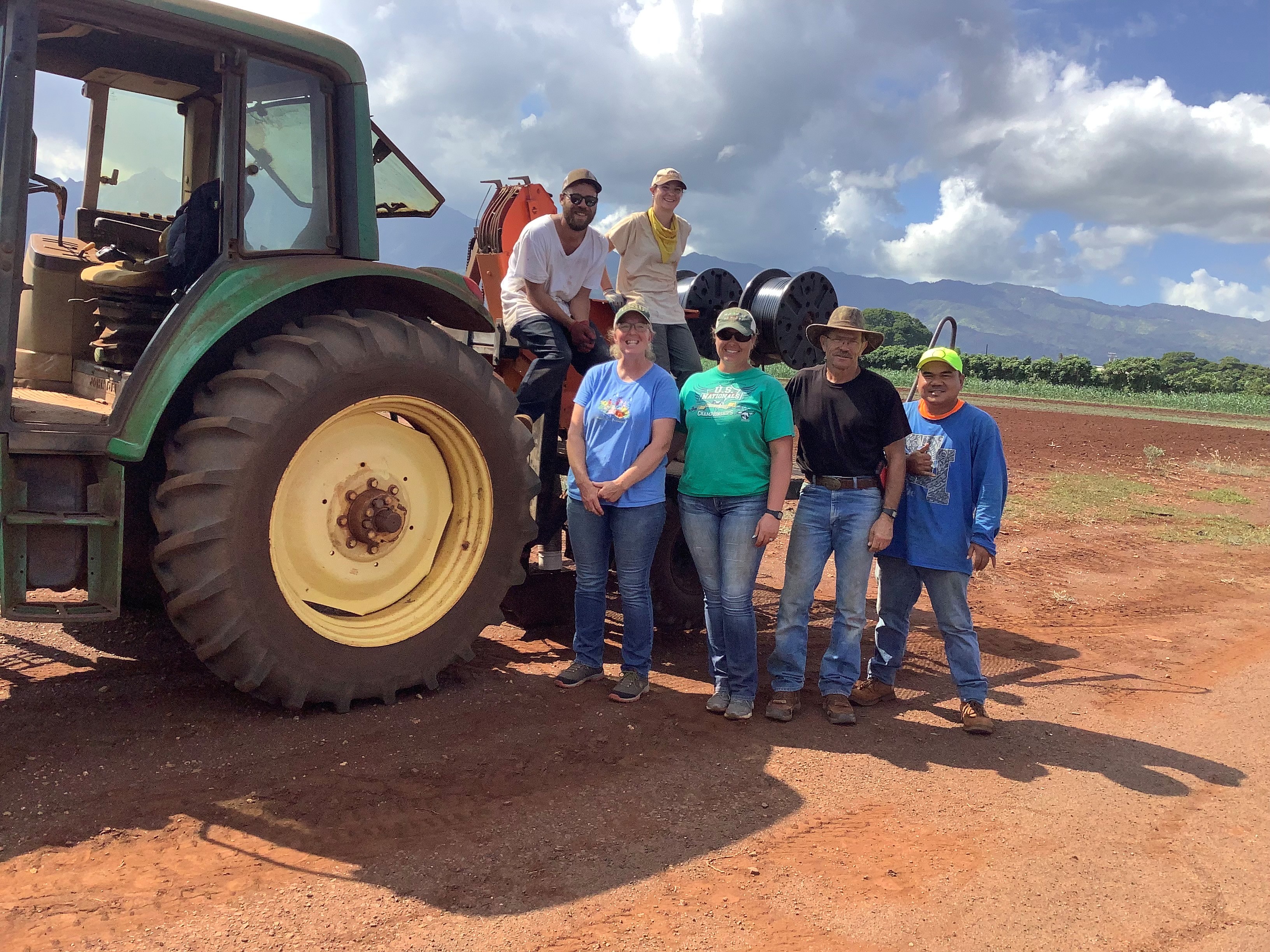
The Colorado Certified crew takes a break during planting of their winter test plots on the North Shore of Oahu, Hawaii.
The 2019 growing season in Colorado was cooler than normal, but overall yields have been average or slightly below average for this year’s crop. All field-grown certified seed in Colorado is produced in the San Luis Valley, located in south-central Colorado at an elevation of 7,600 feet. The 2019 growing season was preceded by an above-average snowpack in the mountains surrounding the San Luis Valley, which was a welcome change from the record-setting drought the previous year.
Seed inspections started June 25, one week later than in 2018. Certified seed growers began killing vines in late July and continued through early August, limiting potential spread of virus by late-season aphid flights.
Post-harvest test samples have been shipped to Hawaii to determine certification eligibility for the 2020 season. Growers should have preliminary results by the beginning of the year. A post-harvest test is required on all certified seed in Colorado, whether it is sold commercially or for recertification. An official 2019 certified seed directory is available online at potatoes.colostate.edu/potato-certification-service. An interactive seed directory can be found at www.coloradocertifiedpotatogrowers.com.
In 2019, Colorado certified seed potato acreage was down overall from 8,813 acres in 2018 to 6,756 acres. The 2019 accepted certified acreage after summer field inspections was 6,180 acres. Rejections were primarily the result of PVY and mosaic, with a few rejections caused by blackleg and variety mix. Total potato acreage (both certified and commercial) in the San Luis Valley was 48,573 acres, down from 51,785 in 2018.
The 2019 top five certified potato varieties in Colorado are:
- Russet Norkotah selections (1,893 acres)
- Canela Russet (548 acres)
- Teton Russet (371 acres)
- Alegria (266 acres)
- Centennial Russet (231 acres)
A wide range of potato varieties are certified in Colorado including multiple varieties of russets, reds, yellows, chippers, fingerlings and specialties.
The Colorado Seed Act and Late Blight Quarantine requires all seed lots imported into Colorado to undergo a post-harvest test and a 21-day late blight incubation test, both of which need to take place prior to shipment. Also, a PVYN tolerance of 1 percent is in place for all seed coming into Colorado.
Idaho
Alan Westra
Southeast Area Manager
Idaho Crop Improvement Association
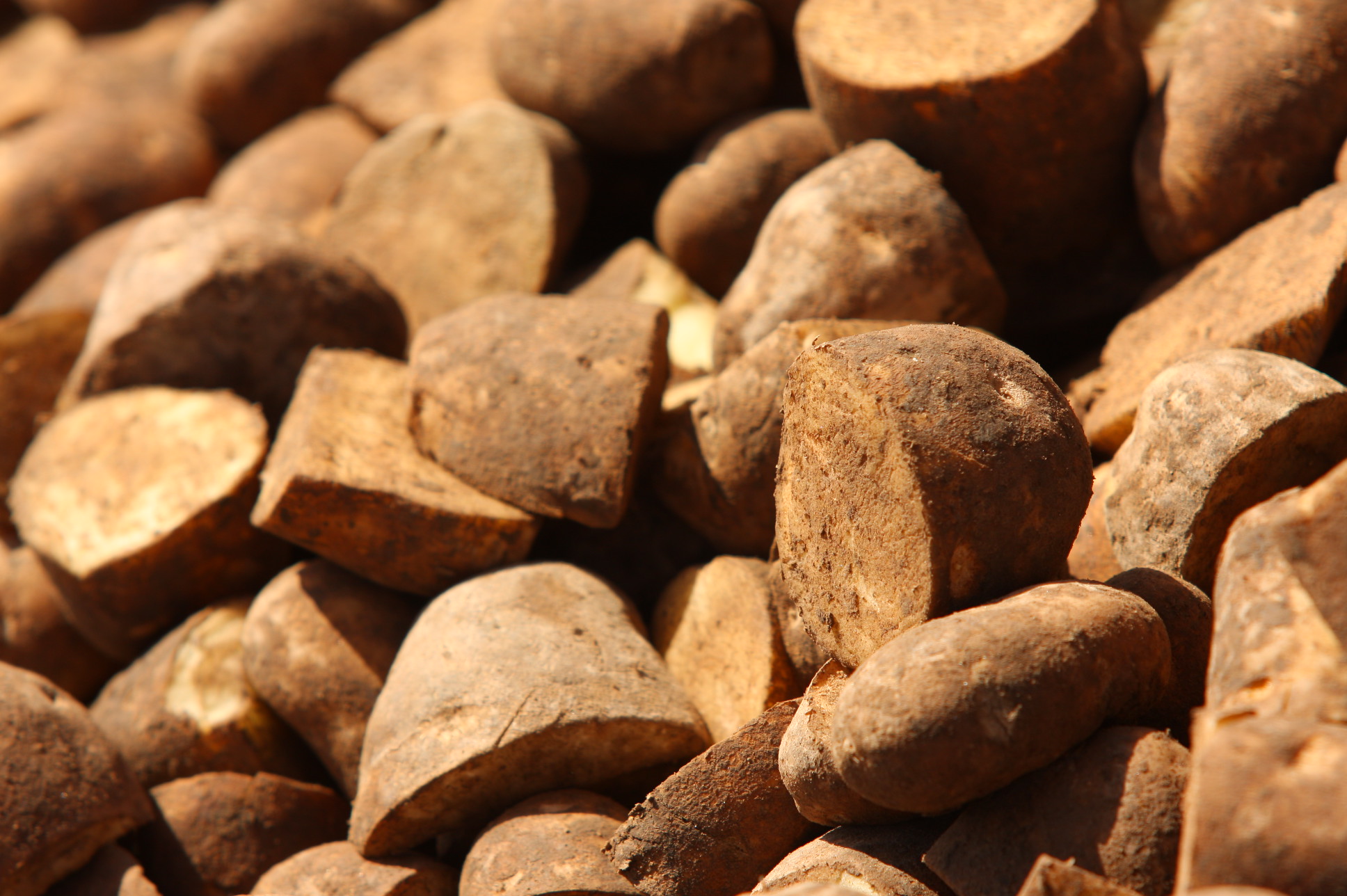
Idaho experienced a somewhat challenging growing season in 2019. Planting began at the normal time, but was interrupted by a 10- to 14-day period of rain. Additionally, late frosts and cooler temperatures delayed the development of those crops planted before the rain.
However, heat later in the season helped the crop catch up. With harvest recently completed, some growers are reporting average to good yields, while others have reported lower than average yields. Quality going into storage was reported as good to excellent. Overall, the 2019 crop appears to have a very nice size profile. Seed health is steady from 2018. The number of seed lots with visually detectable levels of PVY in the field increased only slightly compared to last year, and there were no bacterial ring rot (BRR) detections during field inspections.
At the conclusion of the second round of field inspections, a total of 29,974 acres are eligible for final certification this year. This is essentially unchanged from 2018. Excluding proprietary genetics, the 2019 acreage accepted for certification represents a total of 119 varieties, selections and advanced clones. For 2019, the top varieties were:
- Russet Burbank: 39 percent of total acreage accepted)
- Russet Norkotah (all strains): 18 percent
- Ranger Russet: 12 percent
- Clearwater Russet: 5 percent
- Alturas: 4 percent
- Umatilla Russet: 2 percent
Significant movement occurred in Clearwater, Alturas and Umatilla acreage (+38, + 26 and -12 percent, respectively) compared to the 2018 crop. A complete listing of this year’s seed potato crop is available in the 2019 Idaho Certified Seed Potato Directory, posted at www.idahocrop.com.
Seed buyers should be reminded that the nomenclature used to describe Idaho seed potato generations was changed to a “field year” system, effective with the 2019 crop. This nomenclature is similar to that currently used by a number of other certification programs and is intended to promote standardization and transparency within the seed potato industry by designating generations by the actual number of years that the seed has been produced in soil. Please note that there are no changes to the tolerances associated with the various field generations.
Maine
Eric Hitchcock
Seed Certification Program Manager
Maine Department of Agriculture, Conservation and Forestry
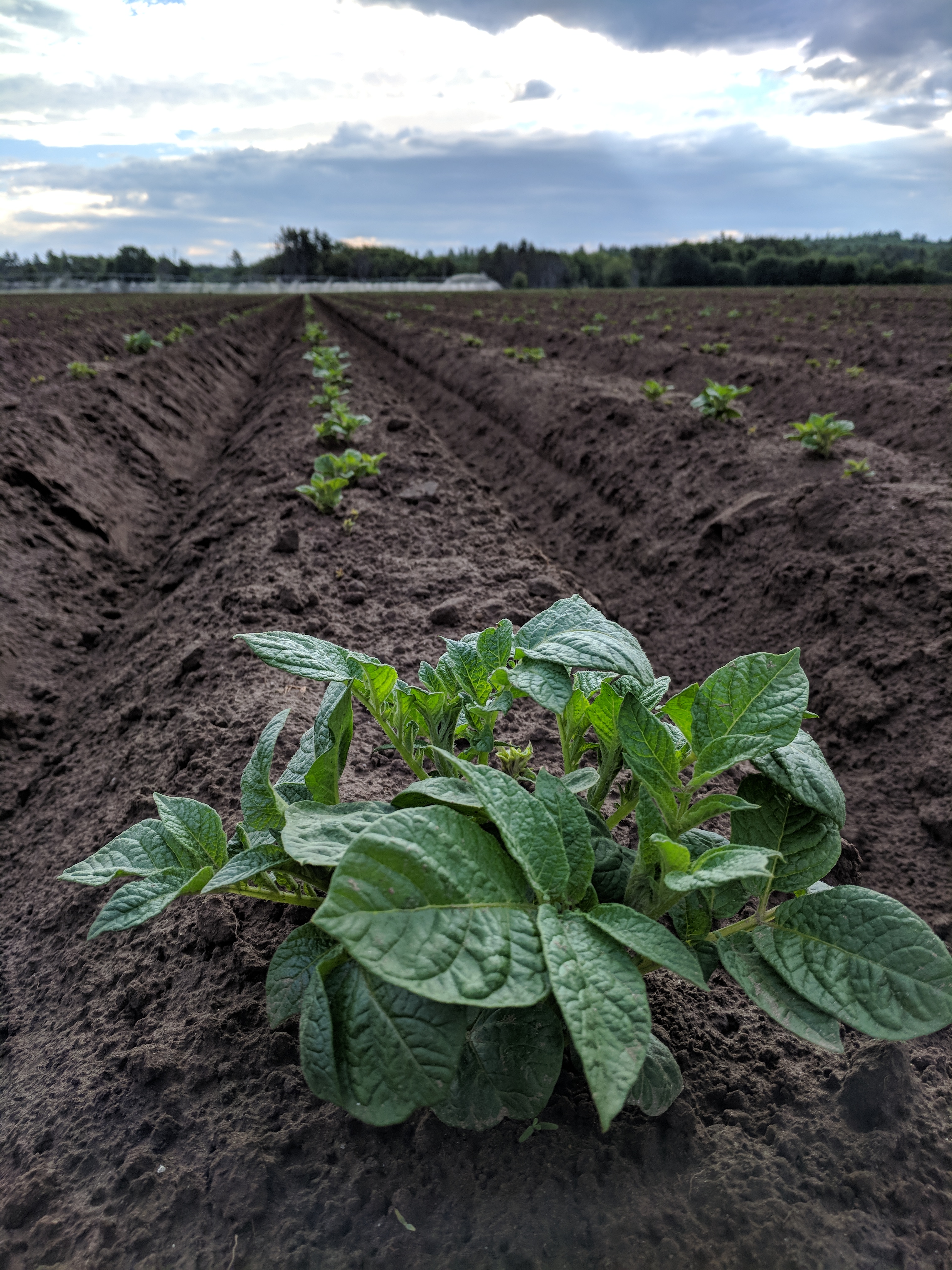
Potatoes emerge at Green Thumb Farms in Fryeburg, Maine.
The 2019 growing season in Maine was very similar to what growers experienced in 2017 and 2018 with a cool spring and prolonged dry spells for the rest of the growing season in Aroostook County. Southern and central Maine similarly experienced dry periods. Luckily, certain growing areas received rain events later in the season to help sustain the crop.
Overall, the 2019 crop appears to be very healthy, despite average to low rainfall in some areas. As of Sept. 30, the certification program has 9,806 acres field certified from 110 farms.
The top five varieties entered for certification in Maine in 2019 are:
- Atlantic: 914 acres
- Russet Burbank (MT strain): 785 acres
- Caribou Russet (PVP): 710 acres
- Lamoka (PVP): 679 acres
- Snowden: 629 acres
Inspectors are now performing PCN sampling and are in preparation for laboratory PVY post-harvest testing. This year marks two years of full post-harvest laboratory testing for the Maine Department of Agriculture. All samples will be ELISA post-harvest tested at the certification laboratory in Presque Isle, Maine.
Minnesota
Eric Byre
Plant Protection Program Supervisor
Minnesota Dept. of Agriculture
The 31 seed potato growers in Minnesota certified 6,134 acres for crop year 2019, a slight increase from the 5,932 acres in 2018. Russet Burbank was the variety with the most acres planted.
Growers experienced a cool, late spring, with the northern tier of the state experiencing delays in planting due to snow through April. Most growers were in the field and planting in May, with all completed by mid-June. As the growing season progressed, the temperatures warmed, rain fell consistently, and growers were excited about potential yields. Minnesota Department of Agriculture (MDA) inspectors were busy, with three inspections conducted on each certified seed potato lot. Ultimately, 600 acres were rejected due to excessive mosaic, varietal mix or failure to meet eligibility requirements.
Harvest was difficult, with some regions receiving up to 14 inches of rain from Labor Day to the end of October. The brunt of the heavy rainfall was in the Red River Valley and northern Minnesota. Fifty-two certified seed lots, representing over 700 acres, were totally lost due to the excess moisture. In addition, not all remaining acreage was able to be harvested. This will have an impact on seed potato production in the area for the foreseeable future. Minnesota governor Tim Walz and agriculture commissioner Thom Peterson held a roundtable discussion with growers and industry officials at the Minnesota Department of Agriculture office in East Grand Forks to discuss the difficulties the growers experienced with the harvest, and to provide some support moving forward. Overall, the quality of the potato seed that was able to be harvested is good to excellent.
The Minnesota Department of Agriculture Potato Inspection Unit uses a generation system and remains vigilant in detecting potato virus and other disease. With this in mind, the program signed the APHIS MOU for Necrotic Virus Management Plan in July. Following every harvest, growers submit samples for the post-harvest winter test on Oahu, Hawaii. In the fall of 2019, 223 samples were submitted for this program. The samples will be planted, and each lot observed visually for stand, vigor and potato virus throughout the winter. All positive potato virus visual observations are confirmed with a laboratory test conducted at the University of Hawaii. Once complete, the results are communicated to the growers and industry.
For copies of the Minnesota certified seed potato directory, visit the Minnesota Department of Agriculture website (www.mda.state.mn.us) or call (218) 773-4956 to be added to the mailing list.
Montana
Nina Zidack
Director
Montana Seed Potato Certification Program
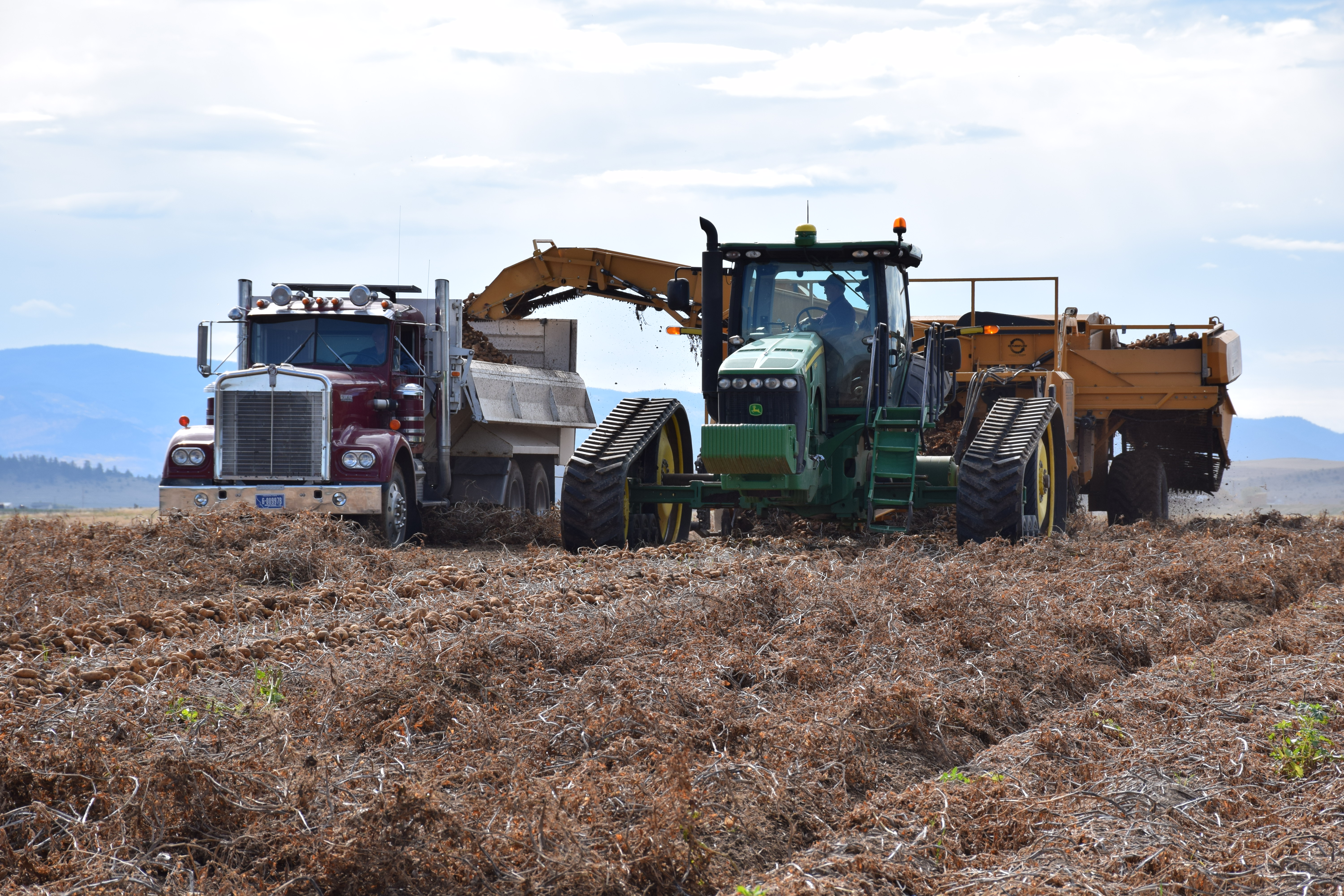
Harvest at Dan Kimm Seed Potatoes in Manhattan, Mont.
The summer of 2019 proved to be cooler than average throughout most of Montana. With mild conditions, there was very little stress to crops throughout the state, and growers are reporting very strong yields and good quality. Some growers received hail in August, but most crops were far enough along that yield was not reduced dramatically. While many other potato-growing areas experienced wet conditions and frost before the end of harvest, Montana growers were fortunate to have about 95 percent of their potatoes harvested before a severe freeze.
Seed potato acreage has held very steady over the past 10 years at just over 10,000 acres. In 2019, Montana seed potato acreage is up slightly to 10,440 acres, which represents a minor increase when compared to 10,355 acres in 2018. Russet Burbank is still the dominant variety but is down slightly from 3,921 acres in 2018 to 3,786 in 2019. Umatilla Russet is the second-most widely produced variety in Montana but has dropped from 1,789 acres in 2017 to 1,376 acres in 2019. Ranger Russet acreage is up from 1,172 acres in 2018 to 1,284 , in 2019. Clearwater Russet acreage continues to rise and is up from 1,016 acres in 2018 to 1,211 in 2019. It is now firmly in fourth place in terms of Montana seed acreage, displacing Alturas from the top five varieties two years ago.
Norkotah Russet selections were up from 997 to 1,116 acres in 2019. Alturas rebounded slightly this year, increasing from 558 acres in 2018 to 623 acres. Standard Norkotah acreage remains very low and now accounts for only 41 acres in Montana.
Norland and Dark Red Norland are the most widely grown colored varieties in Montana at 110 acres combined. Traditionally, chip varieties have not been widely grown in Montana, but growers there are currently increasing with Atlantic, Snowden and Lamoka together making up 99 acres of Montana seed in 2019.
A total of 55 varieties of potatoes were registered for certification in Montana in 2019.
North Dakota
Kent Sather
Director, Potato Programs
North Dakota State Seed Department
About 17 percent of North Dakota certified seed potato 2019 crop was not harvested. Unprecedented late September and early October rainfall, along with a historical blizzard on Oct. 11, halted North Dakota potato harvest in its tracks. Subfreezing temperatures later in October ended any hopes for additional harvesting. This production year simply didn’t end very well.
Nor did the year have an ideal beginning. After a seven- to 10-day delay in planting due to cold temperatures, 27 North Dakota certified seed growers submitted a total of 13,037 acres of seed eligible for recertification, 972 acres fewer than in 2018. Plant growth was behind all summer due to cooler than normal temperatures, with insufficient rain on most of the dryland acres.
The top five varieties grown for seed in North Dakota in 2019 were:
- Norland strains: 2,355 acres
- Umatilla Russet: 1,798 acres
- Ranger Russet: 1,163 acres
- Bannock Russet: 1,136 acres
- Dakota Pearl: 1,109 acres
Seed lot leaf samples as required or requested were tested for PVY and PVX. Results matched field inspection notes. Mosaic levels observed were zero or very low, with only two lots being rejected. Inspectors continued to look for Dickeya dianthicola symptoms. Suspect plants were lab-tested. No positives have been confirmed. Additional tuber screening for Dickeya will be done at a grower’s request.
Phytophthora infestans was a minimal threat in 2019. Even so, growers were encouraged to use proactive fungicide applications. No late blight was found during inspections in certified seed lots. Growers were also attentive to aphid counts and were encouraged to use protective oils, insecticides and vine kill as early as possible.
Early-generation seed lots planted in isolation inspected free from viruses. These seed lots provide the basis for future North Dakota seed production. North Dakota State Seed Department seed stock staff harvested a record mini-tuber crop in June and October, providing a clean seed source for future years.
The 2019 North Dakota seed directory can be obtained by calling the North Dakota State Seed Department at (701) 231-5000 or accessing online at www.nd.gov/seed.
Oregon
Jeff McMorran
Certification Specialist
Oregon Seed Certification Service
Certified potato producers in Oregon enjoyed a good year in 2019. Growers and certification inspectors were both pleased with the clear skies this year as opposed to the smoky conditions endured the previous two years. However, low reservoir levels in some areas remain a concern. In total, 2,683 acres of certified seed were produced, slightly down from the last two years. Growing conditions during the season were near ideal, without the excessive heat of some seasons. Except for a rain-delayed planting in some areas, harvest went well overall but slowed down somewhat in late-harvested fields due to cold night temperatures and accompanying concerns for chill or freeze injury.
Summer field readings for disease were low, with none of the acres entered for certification this year being downgraded or rejected due to disease or off-type, though several were withdrawn, primarily for poor stands. Blackleg levels were considerably lower than in previous years, and little mosaic was observed in the field. White mold stem rot seems to be more prevalent in some areas. Tuber quality appears to be above average, with few internal issues, but growers have reported smaller sizing profiles than previous years for the varieties grown. Yields were at or slightly below average values.
Russet-skinned, white-fleshed varieties continue to dominate overall production in Oregon. However, the No. 1 variety certified in Oregon again in 2019 (acreage-wise) was Gala, a yellow-skinned, yellow-fleshed variety, with 269 acres certified. Specialty red, yellow and purple-fleshed varieties continue to gain a foothold in some Oregon seed production areas, as well as some interesting fingerling varieties. For those interested, a complete listing of the varieties and acres produced in Oregon can be found at seedcert.oregonstate.edu/potatoes under “Seed Report and Directory of Growers” and “Oregon Certified Seed Potato Field Readings and Statistics.”
Oregon’s post-harvest winter grow-out has begun. The Oregon Seed Certification Service conducts all its winter grow-outs in media-filled trays in the greenhouse following a gibberellic acid dip and a two-week warming period. Last year, this process resulted in nearly 100 percent emergence of most lots and allowed for much earlier readings than the older method of waiting until tuber sprout before cutting. Samples delivered in early October are generally read and PVY sampled by mid-November.
Washington
Benita Matheson
Plant Services Program Supervisor
Washington State Dept. of Agriculture
Plant Protection Division
A total of 3,570 acres of seed potatoes were entered for certification during the 2019 growing season in Washington State, a 111-acre decrease from 2018. The top four varieties grown for seed in Washington in 2019 were:
- Ciklamen: 576 acres
- Chieftain: 387 acres
- Russet Burbank: 349 acres
- Umatilla Russet: 228 acres
The total acres planted include 179 different potato varieties ranging in size from partial-acre plots to 88-acre fields. Most seed lots are smaller than 20 acres in size and include numbered clones, table stock, processing and heirloom variety potatoes. There were 472 individual seed lots from eight separate farms entered for certification in 2019.
Pacific Northwest weather provided near-ideal growing conditions through the 2019 season. Washington State Department of Agriculture staff noted that late blight and blackleg disease pressure were slight to non-existent. Complete field inspection results are available at agr.wa.gov/services.
Harvest began the third week of September—with rains and other factors slowing it for a time—and was completed by late October. Growers enjoyed average to above average yields with generally good quality, size and condition of seed lots going into storage. Seed shipments to southern climates have begun and will continue into the winter months, with the majority of seed being shipped in early spring.
Washington State Certified seed growers have submitted seed lot samples for post-harvest testing, which are taking place for the first time, at the North Shore of Oahu, Hawaii.
Prince Edward Island
Lorraine MacKinnon
Potato Industry Coordinator
Prince Edward Island Department of Agriculture and Land
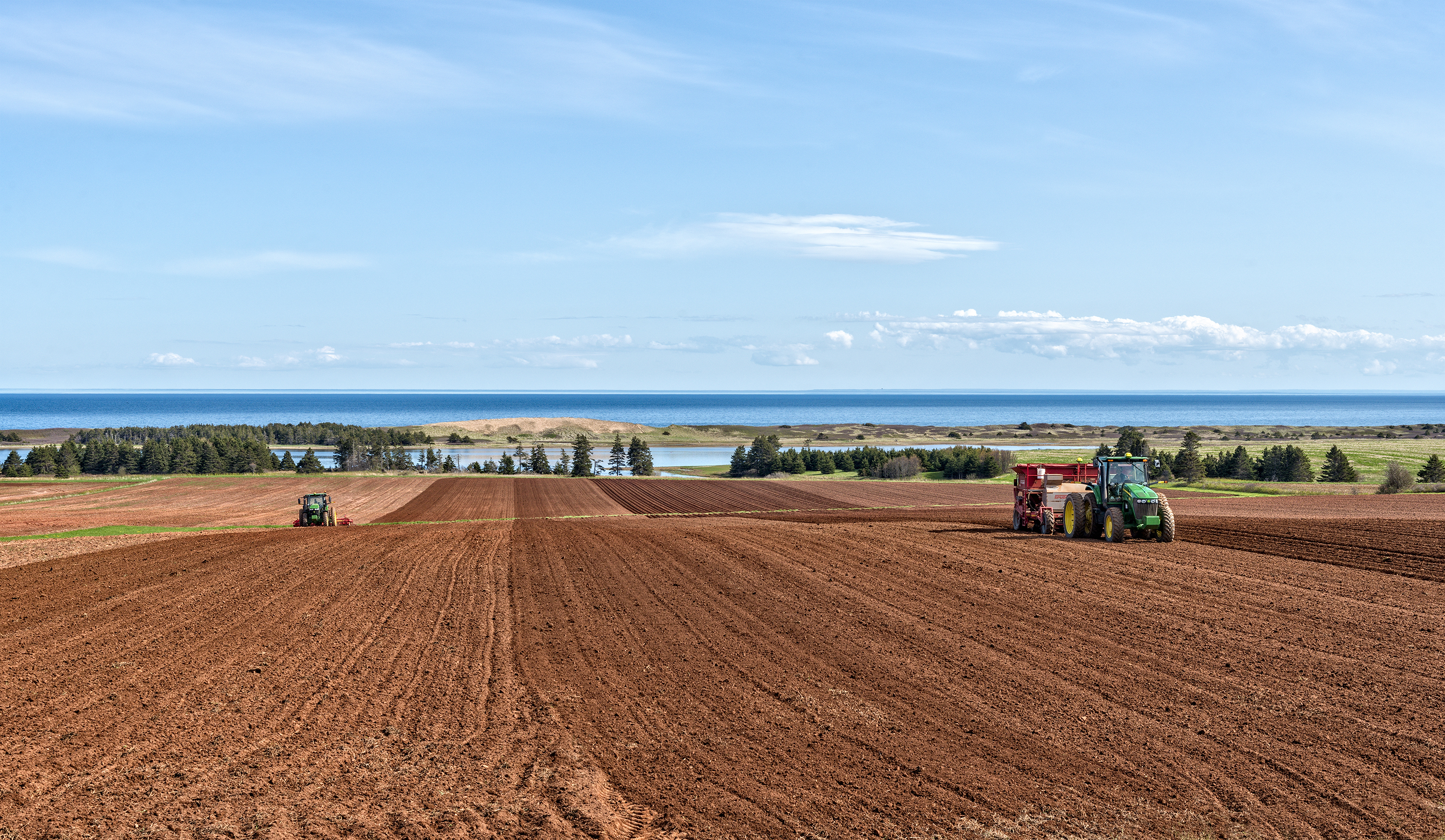
Growers on Prince Edward Island plant potatoes with a pristine view of the North Atlantic. Photo by Mel Gallant
Prince Edward Island, Canada’s largest potato-growing province, experienced a successful season in 2019 with 17,236 acres entered for seed under the Canadian Food Inspection Agency. Approximately 100 growers produce potato seed on P.E.I., and they export to several countries. P.E.I producers grow 100 varieties of potato seed, including a wide selection of processing and table varieties.
Seed production on the Island is supported by the Fox Island Elite Seed Farm, where the P.E.I. Potato Board and its grower-members grow early-generation seed—from tissue culture through to second field generation elite seed—which is sold to Island seed producers. Up to 40 percent of the commercial acreage on P.E.I. has its origins at Fox Island. In addition to the Fox Island facility, there are four operations carrying out in vitro and mini-tuber production.
P.E.I.’s 2019 growing season began with a cool, wet spring and delayed planting for some producers. However, once planted, the fields established quickly with favorable conditions until the latter part of July and August, when it became very dry. In early September, P.E.I. experienced post-tropical storm Dorian, which brought 75-mile-per-hour winds and rainfall amounts in excess of 4 inches in some areas. Due to the dry conditions throughout the summer, the ground seemed able to absorb this moisture in advance of harvest. Although some plants suffered wind damage, the overall effect to the potato crop was minimal.
Seed producers went into the 2019 growing season with low levels of virus from post-harvest testing carried out in the winter. P.E.I. maintains a virus cap, which stipulates that only seed with a combined virus level (PVY and PVX) of lower than 3 percent can be planted, regardless of the seed class. The virus cap has been in effect for several years. This cap, along with the isolated nature of the Island and decreasing numbers of aphids, are factors which have led to the P.E.I. seed industry enjoying several years of low-virus, high-quality seed potatoes.
The top varieties produced for seed on P.E.I. in 2019 (with data released) were Russet Burbank, Eva, Goldrush, Shepody and Dakota Russet. The crop is now in storage, and post-harvest testing results will be available in early winter.
For a detailed listing of seed available for the 2020 growing season, please refer to the 2019 P.E.I. Seed Potato Certification and Grower Directory at www.princeedwardisland.ca.
For further information on the P.E.I. potato seed industry, contact P.E.I. Potato Board seed coordinator Mary Kay Sonier at potato@peipotato.org.
Quebec
Jean-Luc Therrien
Director of R&D
Seed Sales Representative
Quebec Parmentier, Inc.
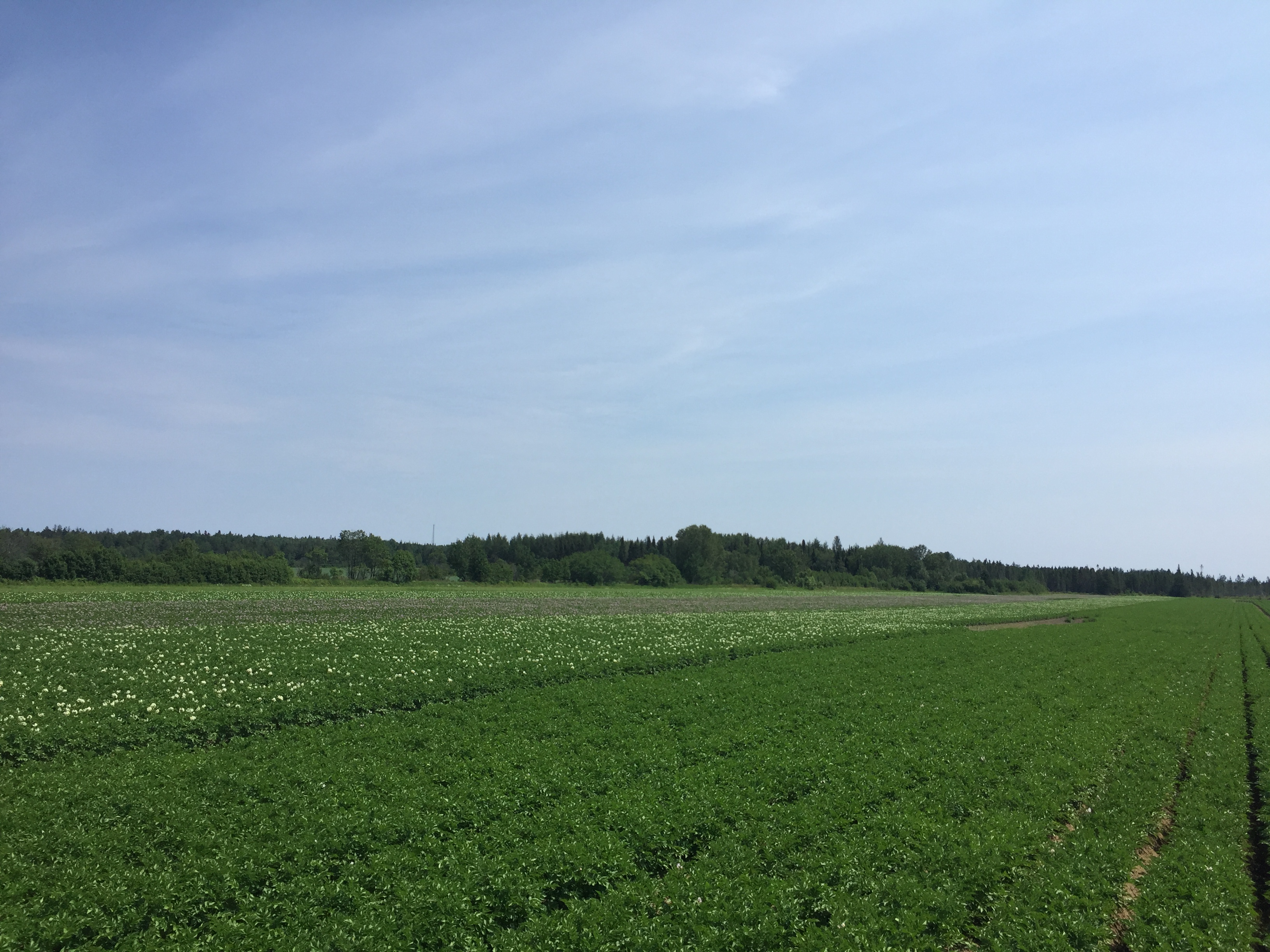
Seed potatoes with multiple varieties in bloom in Saint-Ambroise, Quebec
Most Quebec seed potato growers are located in the Saguenay-Lac Saint Jean region and along the Lower South Shore of the St. Lawrence River. To guarantee superior quality and excellent phytosanitary status, most growers are located within a protected zone, where stringent phytosanitary regulations are in place. The region’s cooler climate also allows for less pressure from aphids, keeping virus levels very low.
In 2019 in Saguenay, weather conditions were close to perfection during the growing season, and fall conditions allowed for all potatoes to be harvested. Yields are higher than average, and quality is good. In contrast, the Lower South Shore suffered from a cold, wet spring, slowing planting. The growing season was adequate despite a drought. However, the 2019 drought was less severe than in the previous year and affected yields in a less drastic way. Yields fell within the average, and quality in that region was also good.
All across Quebec, no late blight cases were reported by seed growers. All fields were inspected for blackleg, with no severe cases reported.